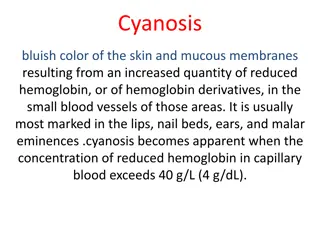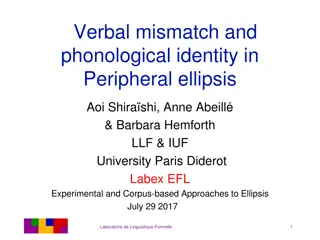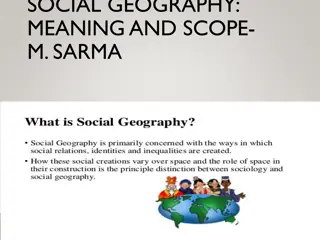The Geography of New Working Spaces and Their Impact on Peripheral Areas
This presentation discusses the COST Action CA18214 focusing on new working spaces (NeWSp) and their role in promoting regional competitiveness, entrepreneurial environments, social inclusion, and spatial regeneration in peripheral areas. It explores the structure of the presentation, types of third-places for work, and defines NeWSp as collaborative and creative spaces, makerspaces, and other innovative work environments.
Download Presentation

Please find below an Image/Link to download the presentation.
The content on the website is provided AS IS for your information and personal use only. It may not be sold, licensed, or shared on other websites without obtaining consent from the author.If you encounter any issues during the download, it is possible that the publisher has removed the file from their server.
You are allowed to download the files provided on this website for personal or commercial use, subject to the condition that they are used lawfully. All files are the property of their respective owners.
The content on the website is provided AS IS for your information and personal use only. It may not be sold, licensed, or shared on other websites without obtaining consent from the author.
E N D
Presentation Transcript
The geography of New Working Spaces and the impact on the periphery COST Action CA18214 By Ilaria Mariotti, CA18214 Chair 14 October 2020, EWCR 14 October 2020, EWCR COST is supported by by the EU Framework Programme Horizon 2020
Structure of the presentation What is CA18214, aim and members What are new working spaces-NeWSp (definition and typologies)? Are the NeWSp able to promote new regional competitiveness, entrepreneurial milieus, social inclusion and spatial regeneration of peripheral areas?
Cost Action: 4 years, End Date: 30/09/2023 MC Chair: Ilaria Mariotti (DAStU-POLIMI, IT) MC Vice Chair: Pavel Bednar (Thomas Bata University, Zlin, CZ) Communication Manager : MinaDi Marino (Norvegian University of Life Sciences, NO) 28 COST Members Albania, Austria, Belgium, Bulgaria, Czech Republic, Estonia, France, Germany, Greece, Hungary, Ireland, Italy, Malta, Moldova, Netherlands, North Macedonia, Norway, Poland, Portugal, Romania, Serbia, Slovakia, Spain, Sweden, Switzerland, Turkey, United Kingdom. 1 Cooperating Member Israel 3 Observer country USA, Canada, Lebanon 3
Different types of third-places for work Third places , introduced by a sociologist as an informal social meeting place separate from the two conventional environments of home (first place) and the productive workspace/office (second place) (Individual)? Work? Services? Offices? Startup? Accelerators? CoWorking? Spaces? Business? Incubators? ? Learning? New? Learning? Spaces? Impact? Hub? Maker? Space? Fab? Lab? Hacker? Space? Discover-Play? 2012? 2001? 2005? 2006? 1959? 1978? 1995?
Definition of NeWSps D.1.1 Internal working paper on preliminary knowledge about main characters of case studies The abbreviation NeWSps includes several new working spaces, which can be divided in the following three categories: Collaborative and creative working spaces (coworking spaces and smart work centres); Makerspaces and other technical spaces (makers spaces, Fab Labs, open workshops); the other new working spaces (hackerspaces, living lab and corporate labs) informal NeWSps (in coffee shops and libraries)
The increasing number of CSs worldwide The number of CSs and their members worldwide (2005-2020) 4000000 30000 Coworking spaces (CSs) are regarded as serendipity accelerators 26,300 3500000 25000 22,400 3000000 Number of members designed to host the creative class and entrepreneurs who isolation and to find a convivial environment favouring the development of collaborative communities, which may lead to an increase in informal exchange, interaction with others, knowledge transfer, and business opportunities. 18,700 20000 Number of CSs 2500000 endeavour to break 13800 2000000 15000 11300 1500000 8700 10000 collaboration and 1000000 5800 3600 5000 500000 60011302070 160 310 75 30 3 0 0 2005 2006 2007 2008 2009 2010 2011 2012 2013 2014 2015 2016 2017 2018 2019 2020 Number of CSs Number of members Source: author based on data from: Global CoWorking Survey, www.deskmag.com
Manufacturing, Maker Spaces and FabLabs Maker spaces: are dedicated to do-it-yourself artisanal activities through a do-it- together approach: for instance, through workplaces and facilities, training programs (for both adults and children) and equipment (digital or not) that are made available to the public in order to share opportunities and tools to create and design . According to the heterogeneity of the maker movement , these workshops may be set up not only by private individuals and companies with commercial interests, but also by associations, schools and universities for amateur and educational purposes (Make in Italy, 2015; Manzo and Ramella, 2015). FabLab: prototyping, learning and collaborating are key factors of maker spaces . Learning activities look quite predominant in the examples of today, interesting to conceive the maker spaces in more multifunctional spaces for families and kids
Direct and indirect effects Coworking Spaces Effects typology Coworkers Direct effects Cost saving (office rental, office energy consumption, employees' commute times); reduce their risks of isolation; increase meeting opportunities; boost business collaboration and promote innovation; foster employee work productivity and working efficiency; reduce CW' commute times and earnings growth; boost CW' job satisfaction and wellbeing. Environment/Planning Reduction of: -pollution, -traffic congestion - energy use patterns both at home and associated with travel/transportation Indirect effects Urban space Practices Confirmation of urban attractiveness Development of spontaneous aggregation in districts Episodic transformation in the public space (temporary installations, permanent/new equipment) -Contribution to the development of innovative services -Extension of daily and weekly cycles of use -Episodic participation in the strengthening of community ties (i.e. Social Streets) -Revitalization of existing retail and commercial activities -Strengthening mini-clusters of creative and cultural productions Mariotti and Akhavan (2020)
Direct effects Coworkers performance Radius Kernel Survey to 236 Coworkers in Italy (2018) matching matching Potential impact of a peripheral localisation on CWs incomes Note: standard errors in parentheses; ** indicates significance at p<0.05; * indicates significance at p<0.10 Being located in a peripheral area for a CW may represent an opportunity to earn more than if he/she were located to work in a urban centre. Outcome: yii, Treatment: w 0.253** 0.223* ATET (0.119) (0.121) N of treated units 17 17 N of control units 235 235 Potential impact of a peripheral localisation on CWs organisations incomes Note: standard errors in parentheses; ** indicates significance at p<0.05; * indicates significance at p<0.10 If an organisation collocates its employees in a CS in a peripheral area it is probably that the organisations incomes will be more performative than those of firms in a CS located in an urban area. The coefficients related to the organisation s incomes show even a higher value (and better significance) if compared to the CWs incomes, which is around 0.3 points above the mean of the dependent variable (yoi), meaning that the localisation in peripheral areas might be fruitfully profitable both for the coworking managers and for the coworking users. Radius Kernel matching matching Outcome: yoi, Treatment: w 0.324*** 0.319*** ATET (0.123) (0.122) N of treated units 17 17 N of control units 235 235 Mariotti and Di Matteo (2020)
Direct effects Coworkers performance Testing the HPs H1: Being localised in a peripheral area foster higher incomes for the CW ACCEPTED H2: Being localised in peripheral area foster higher incomes for the CW s ACCEPTED belonged organisation Similarly, in a recent paper by Mariotti, Akhavan and Di Matteo (2020), CS located in non-pole areas experienced a higher and positive impact on the urban environment (indirect effects) Similarly, in a recent paper by Akhavan and Mariotti (2020), CWs working in CSs located in non-pole areas experienced a higher well- being (direct effects)
Effects on the urban context 45% of CW live within 3 km from their CS, a pattern, which may lead to strengthening the neighbourhood community as they share the sense of place (Stedman 2002) 85% perceive that their CS has had a positive impact on the urban context, in particular, they have stated that the CS offers the following activities having potential neighbourhood effects on its A counterfactual analysis about CS in Italy underlined that those located in non-pole areas (intermediate and peripheral areas) experienced a higher and positive impact on the urban environment (Mariotti, Akhavan, Di Matteo, 2020).
The Maker Movement, Maker Spaces and EFFECTS The Maker Movement (Anderson, 2014) has been heralded as a place-based strategy to invigorate urban manufacturing, offering the millennial generation access to affordable, high-quality technologies and inclusive marketing platforms through which to design new products and get them into the hands of design-savvy consumers. As a place-based economic development strategy the Maker Movement has much to offer: - reenergized public institutions, including libraries and high school shop classes, as maker spaces in support of new product design and development; - helped inspire the next generation of product-making urban entrepreneurs; - when making activities scale through new business creation and coordination, they enhance production-in-place sensibilities through made here marketing campaigns that can also promote local jobs, innovation, and sourcing (Lowe and Vinodrai, 2020).
NeWSp and peripheral areas The CS phenomenon is polarized in bigger agglomerations Nevertheless, there is an urgent need to enlarge the (CS) toolkit for local development in smaller towns and rural areas outside of agglomerations. Furthermore, CSs could be regarded as an opportunity to: Develop Inner Areas Regenerate abandoned buildings/neighbourhoods Host remote workers in spaces closer to their homes Can CS be considered a tool to foster socio-economic growth of peripheral and Inner Areas In Italy: the areas that don t matter ? (Rodr guez-Pose, 2018)
NeWSp and peripheral areas How the Maker Movement revives or concentrates manufacturing traditions within urban limits overlooks its larger geographic potential. The maker economy is also a resource for shoring up and revitalizing manufacturing communities well beyond the metropolis in places presumed to be left behind or irrelevant (Hendrickson, Muro, and Galston 2018; Rodr guezPose 2018a, 2018b).
NeWSps facing Covid-19 pandemic The popularity of the Maker Movement is evident in its quick response to the 2019 20 coronavirus pandemic, with millennial makers across the globe coordinating product design to address shortages of medical productive equipment in the cities where they live and make (Lowe & Vinodrai, 2020). Coworking Spaces are more and more hosting remote workers, even as coworking spaces in Public Libraries in peripheral areas (see Norway and Catalunia)
Webinars: Impacts of COVID on new working spaces COST members have organized 9 webinars from April to July 2020 1. 2. Smart working and coworking, July 21, 2020, by Cecilia Manzo (Italian language) Public libraries as co-working and maker spaces in Nordic countries, June 30, 2020, by Mina Di Marino (English language) Working in post-COVID times: may local coworking be the future trend, June 25, 2020, by Irene Manzini Ceinar (English language) Coworking and real estate in post pandemic times, June 10, 2020 by Chiara Tagliaro (English language) Gender issues and parents in smart-working due to the Covid-19 pandemic, May 28, 2020, by Mina Akhavan (English language) Remote working in the periphery and policy measures, May 20, 2020, by Ilaria Mariotti (Italian language) Impact of Covid19 on the coworking spaces and new working spaces and the renewed role of peripheral areas,May 13, 2020, by Ilaria Mariotti (English language) Impact of Covid 19 on policies and measaures, May 2, 2020, by Carolina Pacchi Coworkes in emergenza Covid, April 25, 2020 by Ivana Pais (Italian language) 3. 4. 5. 6. 7. 8. 9. Video-recording available at our FB page and website Press Review COST CA1821 in the European news
COST Action CA18214, Follow us European Union Website: https://www.cost.eu/actions/CA18214 Project Website: www.new-working-spaces.eu FB page https://www.facebook.com/COSTActionCA18214NeW.Sp Twitter https://twitter.com/newworkingspace FB group (Italy-covid 19) https://www.facebook.com/groups/886380135100739
THANK YOU all Ilaria.mariotti@polimi.it COST is supported by by the EU Framework Programme Horizon 2020











